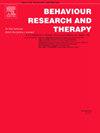超越恐惧的快乐:焦虑障碍患者暴露后的积极情绪及其与威胁预期和治疗结果的联系
IF 4.5
2区 心理学
Q1 PSYCHOLOGY, CLINICAL
引用次数: 0
摘要
基于暴露的CBT在治疗焦虑症方面是有效的,但个体的反应差异很大,这强调了识别和促进暴露机制的必要性。本研究考察了暴露后积极情绪的作用。通过对648例接受暴露治疗的焦虑患者的8416份暴露记录的分析,探讨了暴露练习后出现的积极情绪、希望和喜悦的程度、影响因素及其对治疗成功的作用。暴露后的积极情绪是中等到高的,在重复的暴露练习中略有增加。它们与暴露相关的学习指标(即期望违反和改变以及预测错误学习率)有关,主要通过完成暴露后评估的调整威胁期望来预测,控制基线抑郁症状和影响。高的积极情绪独立地预测了学习指标之外更好的治疗结果,并部分介导了学习指标与治疗结果之间的关联。这些发现表明,积极情绪在一定程度上与暴露期间的成功学习有关,但似乎对整体治疗成功有独特的贡献,强调了通过不同可能的手段加强积极情绪的必要性。本文章由计算机程序翻译,如有差异,请以英文原文为准。
Joy beyond fear: Positive emotions after exposure in patients with anxiety disorders and their link to threat expectancy and treatment outcome
Exposure-based CBT is effective in treating anxiety disorders, but individual responses vary substantially, underlining the need to identify and boost mechanisms underlying exposure. In this study, the role of positive emotions occurring after exposure was examined. In an analysis of 8416 exposure records of 648 anxiety patients undergoing exposure therapy, the degree of positive emotions hope and joy occurring after exposure exercises, their predictors, and their role regarding treatment success were investigated. Positive emotions after exposure were medium to high and increased slightly across repeated exposure exercises. They were associated with exposure-related learning indicators (i.e., expectancy violation and change as well as the prediction-error learning rate) and were mainly predicted by adjusted threat expectancy assessed after completing exposure, controlling for baseline depressive symptoms and affect. Higher positive emotions independently predicted better treatment outcome beyond learning indicators, and partially mediated the association between learning indicators and treatment outcome. These findings indicate that positive emotions are partly associated with successful learning during exposure but seem to have a unique contribution to overall treatment success, underlining the need to strengthen positive emotions via different possible means.
求助全文
通过发布文献求助,成功后即可免费获取论文全文。
去求助
来源期刊

Behaviour Research and Therapy
PSYCHOLOGY, CLINICAL-
CiteScore
7.50
自引率
7.30%
发文量
148
期刊介绍:
The major focus of Behaviour Research and Therapy is an experimental psychopathology approach to understanding emotional and behavioral disorders and their prevention and treatment, using cognitive, behavioral, and psychophysiological (including neural) methods and models. This includes laboratory-based experimental studies with healthy, at risk and subclinical individuals that inform clinical application as well as studies with clinically severe samples. The following types of submissions are encouraged: theoretical reviews of mechanisms that contribute to psychopathology and that offer new treatment targets; tests of novel, mechanistically focused psychological interventions, especially ones that include theory-driven or experimentally-derived predictors, moderators and mediators; and innovations in dissemination and implementation of evidence-based practices into clinical practice in psychology and associated fields, especially those that target underlying mechanisms or focus on novel approaches to treatment delivery. In addition to traditional psychological disorders, the scope of the journal includes behavioural medicine (e.g., chronic pain). The journal will not consider manuscripts dealing primarily with measurement, psychometric analyses, and personality assessment.
 求助内容:
求助内容: 应助结果提醒方式:
应助结果提醒方式:


